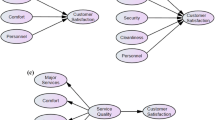Abstract
The analysis of Customer Satisfaction is an important tool in planning business activities. It allows firms to identify which features and attributes are important for their services or products. In this paper we define nine possible scenarios for a public train transport, by means of design of experiments. Each scenario is identified by some quality factors with 3 possible levels. Our aim is to select the scenario that maximizes the satisfaction of potential users. To define the levels composing the best feasible scenario we propose to use Cumulative Correspondence Analysis (by Taguchi method) and the Likelihood Ratio in the logistic regression model. It is also suggested a suitable scenario both for users and company provider.

Similar content being viewed by others
References
Agresti, A. (2013). Categorical data analysis (3rd ed.). New York: Wiley.
Beh, E. J., D’Ambra, L., & Simonetti, B. (2011). Correspondence analysis of cumulative frequencies using a decomposition of Taguchi‘s statistic. Communications in Statistics: Theory and Methods, 40, 1620–1632.
Bolton, R. N., & Drew, J. H. (1991). A longitudinal analisys of the impact of service changes on customer attitudes. Journal of Marketing, 55(1), 1–10.
Ciavolino, E., & Carpita, M. (2015). The GME estimator for the regression model with a composite indicator as explanatory variable. Quality and Quantity, 49(3), 955–965.
Ciavolino, E., & Dahlgaard, J. J. (2007). ECSI—Customer satisfaction modelling and analysis: A case study. Total Quality Management and Business Excellence, 18, 545–555.
Ciavolino E., D’Ambra A., Venuleo C., & Vernai M. (2017). Non-symmetrical correspondence analysis to evaluate how age influences the addiction discourses. Statistica e Applicazioni, XV(1), 3–18
Cronin, J. J., & Taylor, S. A. (1992). Measuring service quality: A reexamination and extension. Journal of Marketing, 56(3), 55–68.
D’Ambra, L., Amenta, P., & D’Ambra, A. (2017). Decomposition of cumulative chi-squared statistics, with some new tools for their interpretation. Statistical Methods and Applications, https://doi.org/10.1007/s10260-017-0401-3.
D’Ambra, L., Köksoy, O., & Simonetti, B. (2009). Cumulative correspondence analysis of ordered categorical data from industrial experiments. Journal of Applied Statistics, 36(12), 1315–1328.
Dowie, U., Helferich, A., Herzwurm, G., & Schockert, S. (2005). QFD for services: The service matrix of matrices. In: 11th International symposium on QFD. Izmir, Turkey
Hauser, J. R., & Clausing, D. (1988). The house of quality. The Harvard Business Review, 3, 63–73.
Kamalja, K., & Khangar, N. (2017). Multiple correspondence analysis and its applications. Electronic Journal of Applied Statistical Analysis, 10(2), 432–462.
Krivobokova, O. V. (2009). Evaluating customer satisfaction as an aspect of quality management. World Academy of Science, Engineering and Technology, Vol. 53
Lombardo, R., & Ringrose, T. (2012). Bootstrap confidence regions in non-symmetrical correspondence analysis. Electronic Journal of Applied Statistical Analysis, 5(3), 413–417.
Montgomery, D. C. (1996). Introduction to statistical quality control. Hoboken: Wiley.
Nair, V. N. (1986). Testing in industrial experiments with ordered categorical data. Technometrics, 28(4), 283–291.
Nair, V. N. (1987). Chi-squared type tests for ordered alternatives in contingency tables. Journal of American Statistical Association, 82, 283–291.
Nitti, M., & Ciavolino, E. (2014). A deflated indicators approach for estimating second-order reflective models through PLS-PM: An empirical illustration. Journal of Applied Statistics, 41(10), 2222–2239.
O’Connel, A. A. (2006). Logistic regression models for ordinal response variables (Vol. 146). Thousand Oaks: Sage Publications.
Oliver, R. L., & John, E. S. (1989). Consumer perceptions of interpersonal equity and satisfaction in transactions: A field survey approach. Journal of Marketing, 53, 21–35.
Parasuraman, A., Zeithaml, V. A., & Berry, L. L. (1985). A conceptual model of service quality and its implications for future research. Journal of Marketing, 49(Fall), 41–50.
Reilly, N. B. (1999). The team based product development guidebook. Milwaukee, WI: ASQ Quality Press.
Rosenthal, S. R. (1992). Effective product design and development (p. 60430). Business One Irwin, Homewood, Illinois: How to cut lead time and increase customer satisfaction.
Sarnacchiaro, P., & D’Ambra, A. (2011). Cumulative correspondence analysis to improve the public train transport. Electronic Journal of Applied Statistical Analysis: Decision Support System and Service Evaluation, 2(1), 15–24.
Satterthwaite, F. (1946). An approximate distribution of estimates of variance components. Biometrical Bullettin, 2, 110–114.
Taguchi, G. (1966). Statistical analysis. Tokyo: Maruzen.
Taguchi, G. (1974). A new statistical analysis for clinical data, the accumulating analysis, in contrast with the chi-square test. Saishin Igaku, 29, 806–813.
Taguchi, G. (1991a). Taguchi methods case studies from the U.S. and Europe. Michigan: American Supplier Institute.
Taguchi, G. (1991b). Taguchi methods: Research and development. Michigan: American Supplier Institute.
Taguchi, G. (1991c). Taguchi methods: Signal-to-noise ratio for quality evaluation. Michigan: American Supplier Institute.
Takeuchi K., & Hirotsu, C. (1982). The cumulative chi square method against ordered alternative in two-way contingency tables. Technical Report 29, Reports of Statistical Application Research. Japanese Union of Scientists and Engineers.
Tapke, J. (1997). House of quality. Steps in understanding the house of quality. http://www.public.iastate.edu/~vardeman/IE361/f01mini/johnson.pdf.
Author information
Authors and Affiliations
Corresponding author
Rights and permissions
About this article
Cite this article
D’Ambra, A., Amenta, P. & Lucadamo, A. Analyzing Customer Requirements to Select a Suitable Service Configuration Both for Users and for Company Provider. Soc Indic Res 146, 383–394 (2019). https://doi.org/10.1007/s11205-018-1935-y
Accepted:
Published:
Issue Date:
DOI: https://doi.org/10.1007/s11205-018-1935-y




